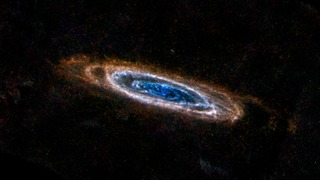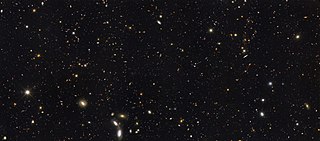Infrared astronomy is a sub-discipline of astronomy which specializes in the observation and analysis of astronomical objects using infrared (IR) radiation. The wavelength of infrared light ranges from 0.75 to 300 micrometers, and falls in between visible radiation, which ranges from 380 to 750 nanometers, and submillimeter waves.

Far-infrared astronomy is the branch of astronomy and astrophysics that deals with objects visible in far-infrared radiation.

The W. M. Keck Observatory is an astronomical observatory with two telescopes at an elevation of 4,145 meters (13,600 ft) near the summit of Mauna Kea in the U.S. state of Hawaii. Both telescopes have 10 m (33 ft) aperture primary mirrors, and when completed in 1993 and 1996 were the largest astronomical telescopes in the world. They are currently the 3rd and 4th largest.

The Spitzer Space Telescope, formerly the Space Infrared Telescope Facility (SIRTF), was an infrared space telescope launched in 2003. Operations ended on 30 January 2020. Spitzer was the third space telescope dedicated to infrared astronomy, following IRAS (1983) and ISO (1995–1998). It was the first spacecraft to use an Earth-trailing orbit, later used by the Kepler planet-finder.

The Infrared Space Observatory (ISO) was a space telescope for infrared light designed and operated by the European Space Agency (ESA), in cooperation with ISAS and NASA. The ISO was designed to study infrared light at wavelengths of 2.5 to 240 micrometres and operated from 1995 to 1998.

NASA's series of Great Observatories satellites are four large, powerful space-based astronomical telescopes launched between 1990 and 2003. They were built with different technology to examine specific wavelength/energy regions of the electromagnetic spectrum: gamma rays, X-rays, visible and ultraviolet light, and infrared light.

The Herschel Space Observatory was a space observatory built and operated by the European Space Agency (ESA). It was active from 2009 to 2013, and was the largest infrared telescope ever launched until the launch of the James Webb Space Telescope in 2021. Herschel carries a 3.5-metre (11.5 ft) mirror and instruments sensitive to the far infrared and submillimetre wavebands (55–672 µm). Herschel was the fourth and final cornerstone mission in the Horizon 2000 programme, following SOHO/Cluster II, XMM-Newton and Rosetta.

Akari (ASTRO-F) is an infrared astronomy satellite developed by Japan Aerospace Exploration Agency, in cooperation with institutes of Europe and Korea. It was launched on 21 February 2006, at 21:28 UTC by M-V rocket into Earth sun-synchronous orbit. After its launch it was named Akari (明かり), which means light in Japanese. Earlier on, the project was known as IRIS.

SRON Netherlands Institute for Space Research is the Dutch expertise institute for space research. The Institute develops and uses innovative technology for research in space, focusing on astrophysical research, Earth science and planetary research. SRON has a line of research into new and more sensitive sensors for X-rays and infrared radiation.
Cosmic infrared background is infrared radiation caused by stellar dust.

The Great Observatories Origins Deep Survey, or GOODS, is an astronomical survey combining deep observations from three of NASA's Great Observatories: the Hubble Space Telescope, the Spitzer Space Telescope, and the Chandra X-ray Observatory, along with data from other space-based telescopes, such as XMM Newton, and some of the world's most powerful ground-based telescopes.
The Exoplanet Characterisation Observatory (EChO) was a proposed space telescope as part of the Cosmic Vision roadmap of the European Space Agency, and competed with four other missions for the M3 slot in the programme. On 19 February 2014 the PLATO mission was selected in place of the other candidates in the programme, including EChO.

The SAFARI imaging spectrometer was the European image sensor of Japanese infrared telescope SPICA and is being developed under the leadership of SRON Netherlands Institute for Space Research. SAFARI is an infrared camera with about 6,000 pixels that can make real ‘photos’ of the sky in three adjacent wavelength areas. Fourier transform spectroscopy (FTS) obtains detailed spectral information, allowing astronomers to determine the chemical composition of the observed celestial sources. The Netherlands Organisation for Applied Scientific Research (TNO) is developing the mechanism of this FTS.

SAFIR is a proposed NASA space observatory for far-infrared light. The plan calls for a single large mirror 5–10 meters (16–33 ft) in diameter, cryogenically cooled to 5 kelvins. This would feed detector arrays sensitive from 5 to 1000 µm. The possibility of servicing such a telescope in space has been evaluated.

The Habitable Exoplanet Observatory (HabEx) is a space telescope concept that would be optimized to search for and image Earth-size habitable exoplanets in the habitable zones of their stars, where liquid water can exist. HabEx would aim to understand how common terrestrial worlds beyond the Solar System may be and determine the range of their characteristics. It would be an optical, UV and infrared telescope that would also use spectrographs to study planetary atmospheres and eclipse starlight with either an internal coronagraph or an external starshade.

Origins Space Telescope (Origins) is a concept study for a far-infrared survey space telescope mission. A preliminary concept in pre-formulation, it was presented to the United States Decadal Survey in 2019 for a possible selection to NASA's large strategic science missions. Origins would provide an array of new tools for studying star formation and the energetics and physical state of the interstellar medium within the Milky Way using infrared radiation and new spectroscopic capabilities.

The Science Programme of the European Space Agency is a long-term programme of space science and space exploration missions. Managed by the agency's Directorate of Science, The programme funds the development, launch, and operation of missions led by European space agencies and institutions through generational campaigns. Horizon 2000, the programme's first campaign, facilitated the development of eight missions between 1985 and 1995 including four "cornerstone missions" – SOHO and Cluster II, XMM-Newton, Rosetta, and Herschel. Horizon 2000 Plus, the programme's second campaign, facilitated the development of Gaia, LISA Pathfinder, and BepiColombo between 1995 and 2005. The programme's current campaign since 2005, Cosmic Vision, has so far funded the development of ten missions including three flagship missions, JUICE, Athena, and LISA. The programme's upcoming fourth campaign, Voyage 2050, is currently being drafted. Collaboration with agencies and institutions outside of Europe occasionally occur in the Science Programme, including a collaboration with NASA on Cassini–Huygens and the CNSA on SMILE.
Cosmic Vision is the third campaign of space science and space exploration missions in the Science Programme of the European Space Agency (ESA). Formulated in 2005 as Cosmic Vision: Space Science for Europe 2015–2025, the campaign succeeded the Horizon 2000 Plus campaign and envisioned a number of missions in the fields of astronomy and solar system exploration beyond 2015. Ten missions across four funding categories are planned to be launched under Cosmic Vision, with the first being CHEOPS in December 2019. A mission to the Galilean moons (JUICE), the first deep space mission with an opportunistic target, and one of the first gravitational-wave space observatories (LISA), are planned for launch as part of the Cosmic Vision campaign.














